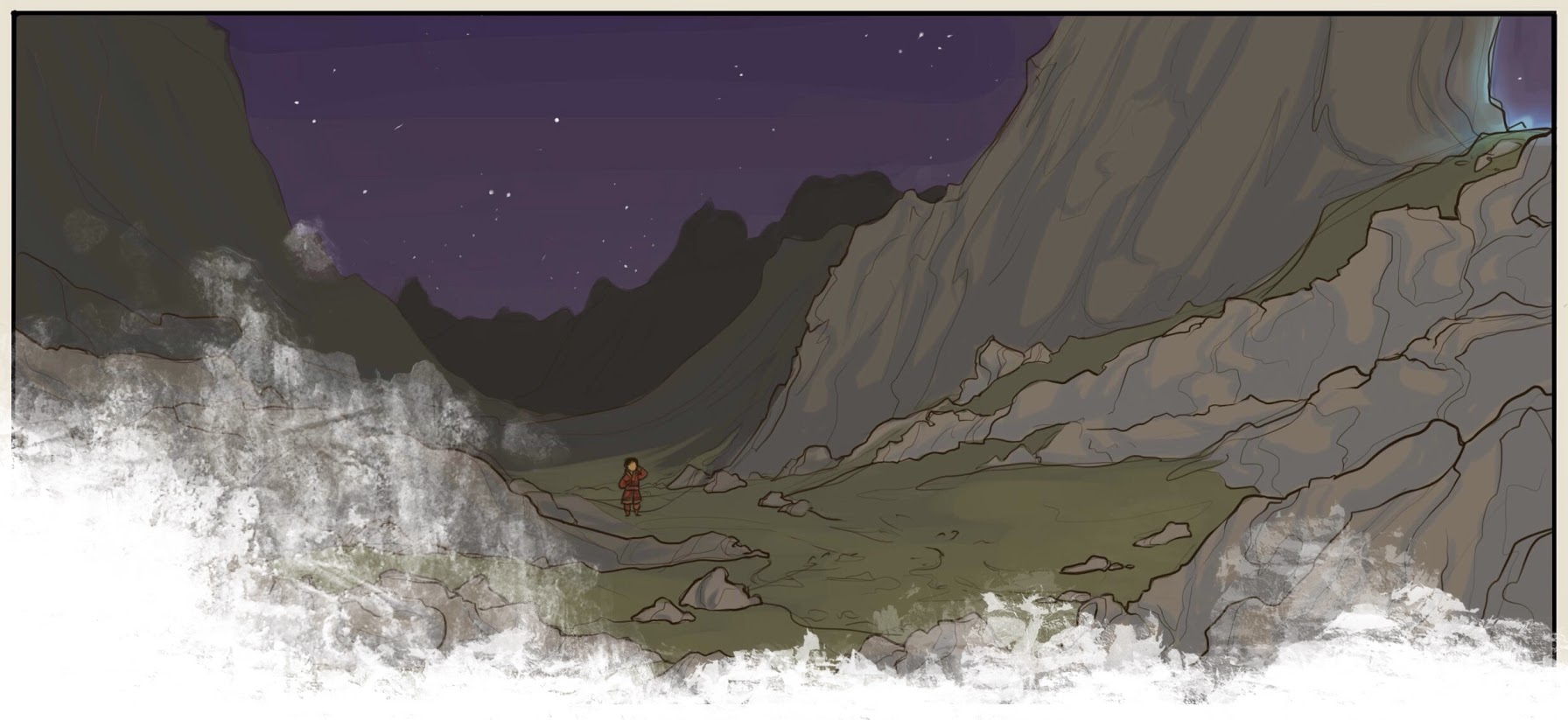The Kheyun Marshes
Introduction
The Kheyun Marshes are one of the most impenetrable wildernesses of Aestis and home to isolated tribes of humans and the more warlike cousins of the Olorian Jaraki, the Kaar Jaraki. These humanoids are larger than the Jaraki and have been known to hunt human beings. At the center of the marshes are a series of interlinked giant freshwater lakes that both humans and Jaraki seem drawn to, their waters having a hypnotic power that attracts all sentient life. The lakes generate the development of strange new forms of life such as the Goragon Islands, an entire archipelago of living islands in the swamps (ranging from hundreds of feet across to half a mile wide) that periodically rise out of the fetid waters of vast mud and earth limbs to migrate, changing the geography of the swamps and potentially crushing anything they land on). Predators like blood spinners which resemble giant blood red stick insects and whose bodies stand above the low lying fog, waiting for the unwary to walk underneath and the Ryvvik - intelligent rat like humanoids who worship the lakes as if they were gods and are also hunted by the Kaar Jaraki. The geography and the dangers of the marshes mean that few have ever sought to colonise and settle here, but it has become home to lone spellcasters wishing to find new spell forges and have solitude in the swamps.The Rubies of the Marshes
The Vannic emperors built their fortresses in the iciest reaches of the Arching Mountains and viewed even the cities that populated the great coastal plains of the Arclands with contempt, so many scholars assumed they barely recognised the existence of thousands of miles of impenetrable marshlands, but for some reason, in the strategic thinking of the Vannic emperors, the marshes were a key consideration. The Archish emperors who followed the Van were also very interested in ensuring that the marshes were not colonised by any one human power. Since the Sundering, Arcish Protectors and other key figures from the Arclands have been keen to ensure that the marshes do not fall into the hands of non humans such as the Kaar Jaraki. Wayfarer scribe Kholis Kharman wrote a letter in the year 212 to Lord Ostradis of the House of Neem in @Har presenting a possible explanation to the mystery of the marshes importance, following an extraordinary find as he trekked across the wetlands.My esteemed friend Ostradis I write to you after these many months from the small crossing town of Odeyla, built of wood and raised out of the very peat and mud of the marshes. The locals, a sly and suspicious folk, but as they have come to accept me among them, they have started to tell me a story that had I not seen evidence of with my own eyes, I would scarely have believed. It was the children at first who told me of a game, where they waded deep in the mud to find a ruby. "There are only fifteen," said a young girl, as she reached deep into brackish water to find some imaginary gemstone. I recall that I nodded indulgently, smiling at the playful imaginings of youth, but the girl was insistant. "There are only ever fifteen rubies, and if more come, we have to put them back, it's always been like that. My grandfather told me first, and he said that his grandfather told him too." There was something about the intensity of the game and the unwavering focus of the children as they searched that told me this was more than just a game. I asked the girl to guide me to her grandfather, who eventually began to tell me a story. "For a thousand years or more there have been folk here in the marshes, told by the lords to the west (a term that denotes Arclander), that the marshes have strange properties. They produce fiery red rubies from their depths. Sometimes there are many, sometimes few, but never fewer than fifteen. The lords to the west told our folk many centuries ago that we must hold fifteen rubies for ten months of the year, throwing them all back into the waters on the eleventh. If the marshes produced more stones than just fifteen, we must throw back one old ruby for every new one we found. If there were more than fifteen at any one time a curse would fall upon the marshes and across the rest of the lands. We were tasked with protecting the stones from fools who would seek to remove them and those who would plunder them. To show that he was not lying, the old man presented me with fifteen of the most perfect almond shaped stones, each worth enough to buy a thousand acres of land. However, there was something more to these stones, a strange and almost imperceptable light that flickered through the heart of them which mesmerised the eye.Upon journeying back to Harenis, Kholis spent over a year at the great library of Harenis deep under Mount Khest, trying to discern where the people of Odeyla had come from originally, in the hope that it might provide him with important clues about who had told them to safeguard the stones. He learned that the Odeylans were part of an ancient Vannic migration westwards during the Vannic civil war which had seen the first civilisation of Aestis destroyed. They had built a much larger outpost deep in the Kheyun Marshes at the behest of Emperor Kartheus, one of the last rulers of the Vannic people. In Mordei Morhannan's Tractus Vannicus, the most widely regarded history of the Vannic people, Kholis found a clue:
For some months Kartheus was consumed with worry, he spoke only to his closest advisors and often spoke solely in Old Vannic, a language that few men have ever grasped, but his daughter, Elsgereth had learned and she listened intently to every conversation from a place of secrecy. She later wrote in her diaries that her father spoke of being visited by beings of light whom he felt so humbled before that he threw himself to the floor and dare not look upon them. She wrote that they spoke in ancient tongue to him, telling him that their time amongst men was drawing to an end and that rulers such as he had a duty to maintain what these beings no longer could. They described to him a place in the earth that issued forth ruby stones of exquisite beauty and power, stones which came from a secret buried so deep in the earth that the hearts and minds of men should never know of it. These stones must be cast back to the earth once a year and no more than fifteen may see the daylight at any one time, should this ever happen a terrible fire would rain down on the world of men and Firg. Kartheus was said to have sent a mighty force to the east to search for the stones, searching for the stones and he found their place of origin where the beings of light instructed him to look.
The Peoples of the Marshes
Marshes are a land that exists beyond civilisation, but it is not without its own settlements and the peoples of the marshes are enormously diverse. Olorians, Veskans, exiled Arclanders, Ghothars, Del'Marahans and Virefolk live alongside Jaraki and Ryvviki and Half Fey. As with Trothkhannan, the fact that the so many live beyond the protection of high city walls encourages a spirit of mutual aid and solidarity. Like the town of Odelya, most marsh villages and settlements are built on raised wooden platforms to cope with flood waters caused by the movement of Goragon Islands. The vast hulking creatures (most Harenian scholars who are permitted to investigate such matters are convinced that the islands are living creatures, but their origin is a mystery), periodically cause chaos as they move, but astute marshfolk have learned to see signs that show when a Goragon is likely to move. A far greater threat to the wellbeing of all those who dwell in the marshes is the presence of the warlike Kaar Jaraki, who see even their own cousins the Olorian Jaraki as prey, looking on the rain forest dwelling amphibians as weak.A Fire in the Heart of Knowing
Our debut Arclands novel is available here. Read A Fire In the Heart of Knowing, a story of desperate power struggles and a battle for survival in the dark lands of Mordikhaan.
Type
Wetland / Swamp




Comments